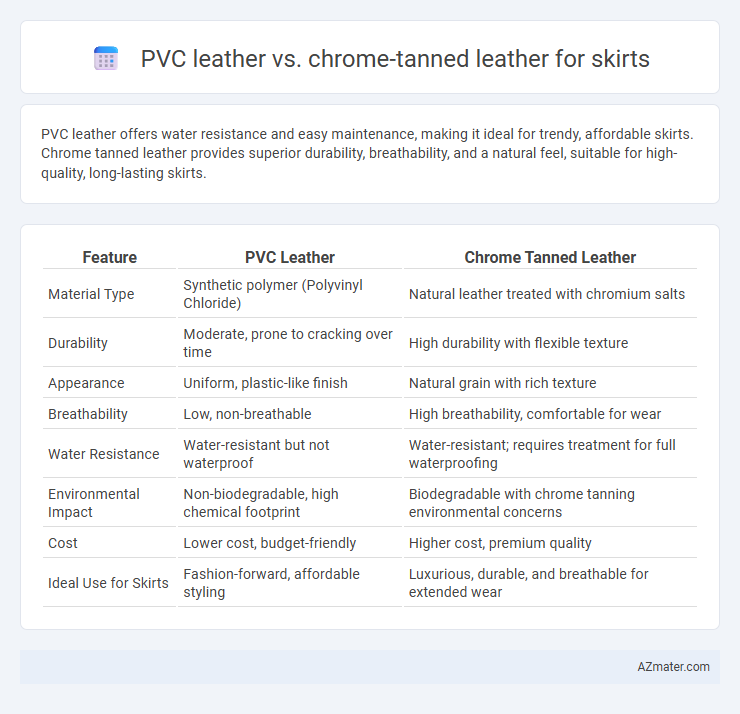PVC leather offers water resistance and easy maintenance, making it ideal for trendy, affordable skirts. Chrome tanned leather provides superior durability, breathability, and a natural feel, suitable for high-quality, long-lasting skirts.
Table of Comparison
| Feature | PVC Leather | Chrome Tanned Leather |
|---|---|---|
| Material Type | Synthetic polymer (Polyvinyl Chloride) | Natural leather treated with chromium salts |
| Durability | Moderate, prone to cracking over time | High durability with flexible texture |
| Appearance | Uniform, plastic-like finish | Natural grain with rich texture |
| Breathability | Low, non-breathable | High breathability, comfortable for wear |
| Water Resistance | Water-resistant but not waterproof | Water-resistant; requires treatment for full waterproofing |
| Environmental Impact | Non-biodegradable, high chemical footprint | Biodegradable with chrome tanning environmental concerns |
| Cost | Lower cost, budget-friendly | Higher cost, premium quality |
| Ideal Use for Skirts | Fashion-forward, affordable styling | Luxurious, durable, and breathable for extended wear |
Introduction to Skirt Materials: PVC Leather vs Chrome Tanned Leather
PVC leather offers a durable, water-resistant option for skirts, combining synthetic materials that mimic the appearance of genuine leather. Chrome tanned leather, derived from animal hides treated with chromium salts, provides a natural, flexible, and breathable fabric known for its softness and rich texture. Understanding these materials helps in selecting skirts based on durability, comfort, and aesthetic preferences.
What is PVC Leather? Composition and Manufacturing
PVC leather, also known as polyvinyl chloride leather, is a synthetic material made by coating a fabric base with a plastic polymer, primarily polyvinyl chloride. Its manufacturing involves a multi-layer process where the fabric is first laminated with PVC resin and then plasticizers, stabilizers, and pigments are added to enhance flexibility, durability, and appearance. PVC leather offers water resistance and affordability, making it a popular alternative to natural chrome tanned leather for skirts and other fashion items.
Understanding Chrome Tanned Leather: The Basics
Chrome tanned leather for skirts is processed using chromium salts, offering durability, softness, and water resistance compared to PVC leather. It retains natural leather characteristics such as breathability and flexibility, making it comfortable for extended wear. This tanning method also allows for vibrant colors and a rich texture, enhancing the skirt's aesthetic appeal and longevity.
Visual Appeal: Differences in Look and Texture
PVC leather offers a uniformly smooth and glossy surface, providing a sleek and modern look ideal for trendy skirts, while chrome-tanned leather boasts a rich, natural grain with subtle variations that create a luxurious and classic appearance. The texture of PVC leather tends to be consistent and synthetic, enhancing durability and ease of maintenance, whereas chrome-tanned leather feels supple with a slightly textured finish, reflecting artisanal quality and aging beautifully over time. Visual appeal in PVC leather skirts is characterized by bold, vibrant colors and a polished effect, contrasting with the warm, organic tones and depth found in chrome-tanned leather skirts.
Comfort and Wearability: Which Material Feels Better?
PVC leather offers a lightweight and water-resistant option for skirts but tends to lack breathability, often causing discomfort during prolonged wear. Chrome-tanned leather, made through a chemical tanning process, provides superior softness, flexibility, and breathability, enhancing overall comfort and wearability. Skirts crafted from chrome-tanned leather adapt better to body movement and temperature, making them a preferred choice for comfort-conscious wearers.
Durability and Maintenance: Longevity Compared
PVC leather stands out for its high durability and resistance to water, stains, and scratches, making it an ideal option for skirts that require low maintenance and long-lasting wear. Chrome tanned leather offers excellent strength and flexibility but demands regular conditioning to prevent drying and cracking, ensuring its durability over time. When comparing longevity, PVC leather maintains a consistent appearance with minimal care, while chrome tanned leather develops a unique patina that can enhance its aesthetic but requires more attentive upkeep.
Environmental Impact: Sustainability and Eco-Friendliness
PVC leather production emits significant amounts of harmful chemicals like dioxins and uses non-biodegradable plastics, contributing to long-term environmental pollution and microplastic waste. Chrome-tanned leather relies on toxic chromium salts that pose serious pollution risks to water sources if not properly managed, although it is biodegradable and can be more sustainable with improved tanning methods. Choosing eco-friendly alternatives such as vegetable-tanned leather or innovative bio-based materials offers a more sustainable option for skirts with lower ecological footprints.
Cost Analysis: Price Differences for Skirts
PVC leather skirts generally cost significantly less than chrome tanned leather skirts due to lower material and manufacturing expenses. While PVC leather skirts typically range from $20 to $50, chrome tanned leather skirts often start at $100 and can exceed $300 depending on quality and brand. The price difference reflects the durability, craftsmanship, and natural characteristics of chrome tanned leather compared to the synthetic, mass-produced nature of PVC leather.
Ethical Considerations: Vegan vs Animal-Based Materials
PVC leather skirts offer a vegan alternative to traditional chrome-tanned leather, eliminating animal cruelty concerns and supporting cruelty-free fashion choices. Chrome-tanned leather involves animal hide processing, raising ethical questions about animal welfare and environmental impact from toxic chemicals used in tanning. Choosing PVC leather skirts aligns with ethical consumerism prioritizing sustainability and animal rights, while chrome-tanned options appeal to those valuing natural materials despite ethical trade-offs.
Choosing the Right Material: PVC or Chrome Tanned Leather for Skirts
PVC leather offers a lightweight, water-resistant, and cost-effective alternative to chrome tanned leather, making it ideal for budget-conscious consumers seeking easy maintenance. Chrome tanned leather provides superior durability, breathability, and a natural texture that enhances comfort and longevity, suitable for premium skirts requiring a luxurious finish. Selecting between PVC and chrome tanned leather depends on desired skirt function, environmental considerations, and price preferences, with chrome tanned leather favored for quality and PVC for affordability and versatility.

Infographic: PVC leather vs Chrome tanned leather for Skirt
 azmater.com
azmater.com